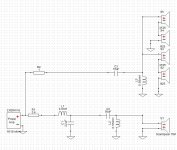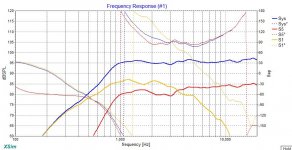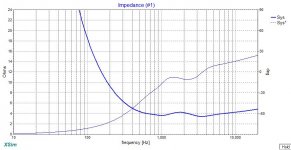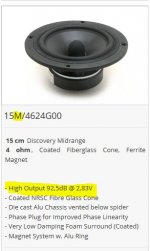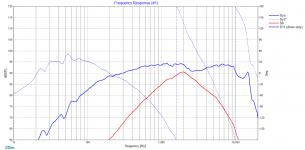Hi Guys, I am not an EE, but like to build speakers as a hobby, apologies for the question.
I want to know if Air-core inductors can be saturated (just like Iron-core/ ferrite ones do and sound terrible and distorted when the core saturates).
I built a crossover for a midrange using Xsim and the FR is perfect for what I need , the phase matches pretty well. However when I physically built and heard the mid (Scan-speak 15M /4624G00 ), it sounds just horrible. Its tinny, ringing, shrilling and almost sounds like a badly designed horn. (without the crossover, the 15M/4624G00 driver sounds lovely).
Its a second order design, with the LP portion being a 0.3mH Air-core in series and a 22uF shunt to ground. The air-core is a Jantzen 20awg and the 22uF is a Aerovox Polypropylene 400v. I have used /heard that cap before and it does not sound bad, but in combination with the inductor, its ringing like a doorbell.
(The HP filter is a 50uF cap in series with a 0.55mH air-core shunted to ground. This 0.55mH is 14awg)
So back to my question, can I saturate a 20 awg Air-core inductor with about 50watts so that it sounds like a badly clipped amplifier ?
I want to know if Air-core inductors can be saturated (just like Iron-core/ ferrite ones do and sound terrible and distorted when the core saturates).
I built a crossover for a midrange using Xsim and the FR is perfect for what I need , the phase matches pretty well. However when I physically built and heard the mid (Scan-speak 15M /4624G00 ), it sounds just horrible. Its tinny, ringing, shrilling and almost sounds like a badly designed horn. (without the crossover, the 15M/4624G00 driver sounds lovely).
Its a second order design, with the LP portion being a 0.3mH Air-core in series and a 22uF shunt to ground. The air-core is a Jantzen 20awg and the 22uF is a Aerovox Polypropylene 400v. I have used /heard that cap before and it does not sound bad, but in combination with the inductor, its ringing like a doorbell.
(The HP filter is a 50uF cap in series with a 0.55mH air-core shunted to ground. This 0.55mH is 14awg)
So back to my question, can I saturate a 20 awg Air-core inductor with about 50watts so that it sounds like a badly clipped amplifier ?
Last edited:
Iron cores has advantages and creates problems.
Advantages: reduces size and copper weight, so reduces copper resistance, reduces stray fluxes and reduce coupling between nearer inductors.
Disadvantages: they are alinear (has saturation and eddy currents depending non linearly with frequency and flux density), they incorporate iron losses (also non linear) and increases a bit the overall weight.
Advantages: reduces size and copper weight, so reduces copper resistance, reduces stray fluxes and reduce coupling between nearer inductors.
Disadvantages: they are alinear (has saturation and eddy currents depending non linearly with frequency and flux density), they incorporate iron losses (also non linear) and increases a bit the overall weight.
Hi,
You can change the distortion ( as well as mH ) characteristics of an air-core if you hold it in place with a metal bolt/screw ( through the middle ). 3Hd distortion definitely increases ( how much depends on the "hardness" of the metal screw.
Apart from that, is there any way your band-pass circuit was designed with too low a working impedance? It's possible your amp doesn't like the values you choose ( if they sent the AC impedance down into 2 ohms territory ). IOW; maybe it is a "badly clipped amp" that you're hearing.

So back to my question, can I saturate a 20 awg Air-core inductor with about 50watts so that it sounds like a badly clipped amplifier ?
You can change the distortion ( as well as mH ) characteristics of an air-core if you hold it in place with a metal bolt/screw ( through the middle ). 3Hd distortion definitely increases ( how much depends on the "hardness" of the metal screw.
Apart from that, is there any way your band-pass circuit was designed with too low a working impedance? It's possible your amp doesn't like the values you choose ( if they sent the AC impedance down into 2 ohms territory ). IOW; maybe it is a "badly clipped amp" that you're hearing.
Last edited:
Here you go. The schematic and the FR with phase.
and the impedance is close to 4ohms at the lower end, just dipping slightly.
No joke, and yes my ears are bleeding...
Schematic below. The Mid is 4 ohms as are all 4 tweeters. but given the series parallel connection of the tweeter, they represent a 4 ohm load overall as well.
and the impedance is close to 4ohms at the lower end, just dipping slightly.
Is this thread a joke? 0.3 mH and 22uF as a LP on a SS 15W. It is a practical example of how to make your ears bleed.
No joke, and yes my ears are bleeding...
no air doesn't saturate
btw those filter values seem strange or maybe mixed up between HP and LP?
can u give more detail
I assume u mean 2nd order crossovers
what are the driver ohm ratings AND at what freq. are u crossing over at?
Schematic below. The Mid is 4 ohms as are all 4 tweeters. but given the series parallel connection of the tweeter, they represent a 4 ohm load overall as well.
Attachments
One more piece of info. my test amplifier is an ancient Kenwood KM-Z1. its 130wpc into 8 ohms. Since it is not natively designed for 4 ohms, I have a "safety" resistor in series on one leg of the outputs. its 6.8ohms. So even with a dead short on my protoboard, the amp will not go below 6.8-7ohms.
The other thing is, if I recall correctly, this is a bridged amplifier, not sure if that affects the crossover (it shouldn't) or if I need to have safety resistor on both output taps (since this is a bridged amp, both taps are hot and there is no ground).
Yes, its for a home theatre application. I regularly blow tweeters given the kind of music (and loudness) I enjoy.
The other thing is, if I recall correctly, this is a bridged amplifier, not sure if that affects the crossover (it shouldn't) or if I need to have safety resistor on both output taps (since this is a bridged amp, both taps are hot and there is no ground).
are u really using 4 tweeters?
the sensitivity of those tweeters will be much higher than the mid, what are your resistor values both mid and tweeter?
and I wonder about that 800 hz crossover on a tweeter with a 700hz Fs
Yes, its for a home theatre application. I regularly blow tweeters given the kind of music (and loudness) I enjoy.
You will get easier help if you upload the whole XSim file. There has been a provision made recently to allow directly attaching such a file extension.
It is not accepting the frd and zma files but allowed the dxo file (attached)
ok so what are those resistor values in the schematic u posted
1 ohm in series with tweeters.
3.4 ohm in series with the mid.
The values are there on the schematic posted on post #8.
Thank you all for chiming in.
Attachments
ok so u have a 90 db mid thats reduced to about 87 db with resistor, mated to a tweeter array with somewhere between 93 and 96 db sensitivity.
serious shrill
to test theory quickly u could increase resistor to tweeters to about 8-10 ohms
this just to test by ear if sensitivity mismatch is at least most of issue. It looks like there may be other issues with crossover values and your resistor at amp output, but the tweeter resistor test is simple easy and can tell u in a min if on right track
BTW take that tweeter cross upto about 1.5k and u may blow less tweeter with little if any negative in sound. Might even be better
serious shrill
to test theory quickly u could increase resistor to tweeters to about 8-10 ohms
this just to test by ear if sensitivity mismatch is at least most of issue. It looks like there may be other issues with crossover values and your resistor at amp output, but the tweeter resistor test is simple easy and can tell u in a min if on right track
BTW take that tweeter cross upto about 1.5k and u may blow less tweeter with little if any negative in sound. Might even be better
Last edited:
ok so u have a 90 db mid thats reduced to about 87 db with resistor, mated to a tweeter array with somewhere between 93 and 96 db sensitivity.
serious shrill
to test theory quickly u could increase resistor to tweeters to about 8-10 ohms
this just to test by ear if sensitivity mismatch is at least most of issue. It looks like there may be other issues with crossover values and your resistor at amp output, but the tweeter resistor test is simple easy and can tell u in a min if on right track
The shrill I hear is from the mid. I have not even assembled the tweeter crossover yet. As soon as I remove the mid crossover, the shrill is gone. It sounds clean and open. So the issue is with the mid crossover.. or one component, since the simulation looks fine to my untrained eye.
Even after I do connect the tweeters, with 2 of them being in series, that's 1/2 voltage or 1/4th the power into each, or -6db. with 2 sets, it gets me an additional 3db, which is about par for the 15M which is rated at 92.5db 2.83v
Dxo file has all the data within itself. Thank you.
Welcome and TY for trying to help out.
Please note, the values of all crossovers are parts I already have. I might have other values of resisters and caps, but not inductors.
Which SS 15 driver exactly? But in general, the xo values for its' bandpass look like the resulting curve is most likely an inverted "V" - very peaky and narrow.
Discovery 15M /4624G00 (5.25" Midrange @ 4ohms)
well that low pass inductor on mid looks way too small for 800 hz cross
as far as sensativity goes, I see 15M rated at around 90 db. The tweeter is 90 too, however two in series will give 90 also BUT 2 in series and then in parallel with two more in series gives a 6 db boost
The 15M shows a sharp rise in output above about 1khz. If that lowpass inductor on mid is too small your going to sound way bright. This may seem strange as it sound ok w/o cross, BUT sometimes sharp level changes in FR at crossover can sound especially bad with the crossover but almost ok with the driver run full range
as far as sensativity goes, I see 15M rated at around 90 db. The tweeter is 90 too, however two in series will give 90 also BUT 2 in series and then in parallel with two more in series gives a 6 db boost
The 15M shows a sharp rise in output above about 1khz. If that lowpass inductor on mid is too small your going to sound way bright. This may seem strange as it sound ok w/o cross, BUT sometimes sharp level changes in FR at crossover can sound especially bad with the crossover but almost ok with the driver run full range
Last edited:
right now, it on the carpet not installed. Eventually, it will go on an open baffle... I do not plan to box it. Just install it on a 5" x 36" plank But the issue is the difference in shrill for the same mid on the same carpet with and without the Xover…What kind of a baffle is this mid in? Baffle measures and the midrange position.
I have often wondered this and am not sure. Here is my thought process for the tweeter loudness. one Xt25 @ 2 watts (2.83v) = 90db or 87db @ 1 watt. Two in series would see 0.5 watts (1.414v) each, meaning 87db x2 = 90db The additional 3db coming from running a pair in parallel ( still 2.83v but 4 watts)well that low pass inductor on mid looks way too small for 800 hz cross
as far as sensativity goes, I see 15M rated at around 90 db. The tweeter is 90 too, however two in series will give 90 also BUT 2 in series and then in parallel with two more in series gives a 6 db boost
The 15M shows a sharp rise in output above about 1khz. If that lowpass inductor on mid is too small your going to sound way bright. This may seem strange as it sound ok w/o cross, BUT sometimes sharp level changes in FR at crossover can sound especially bad with the crossover but almost ok with the driver run full range
Having 2 sets of these series connected in parallel is 90db +90 db = 93db (still 2.83v but since the impedance is 1 ohm, its 8 watts)
If all 4 tweeters were in parallel, then set one would be +3db ie 93db and the second set would further double the 93db into 96 db. So the +6db is for all 4 drivers in parallel not in my case where half of the drivers are in series.
The mid is a Discovery 15M (not 15W) model rated at 92.5db @ 2.83v so just 0.5 db off the tweeter set.
My theory is borne out by the frequency response I posted above in Post #8 which looks very flat to me from 1k onwards where the mids and tweeters would take over from.
Attachments
This is a simulation of a 15M only on a baffle (blue) and filtered with a bandpass filter of yours, the 3.4R padding resistor included. I did my own frd and zma. Is 900 Hz where you want your woofer crossed, and 3.3 kHz for the tweeter?
Attachments
Last edited:
- Status
- This old topic is closed. If you want to reopen this topic, contact a moderator using the "Report Post" button.
- Home
- Loudspeakers
- Multi-Way
- Question on distorted sounding Inductors
